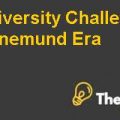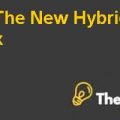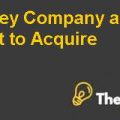The Toys “R” Us LBO Case Solution
Transaction Overview
Transaction summary
There are three private equity investors who are concerned about investing in Toys “R” Us. In 2005, the company decided to sell the entire worldwide operations to the consortium of Bain Capital, KKR, & Vornado Realty for 26.75 dollar per share, in a 6.7 billion dollar transaction. The winning bid for company is 26.75 dollars per share, which represents an aggregate value of 6.7 billion dollar including fee of transaction.
EV multiple & leverage summary
On the basis of the adjusted EBITDA of 780 million dollars;the enterprise value multiple is 9.4x and total transaction value is 9.9x and 7721 million dollars for the transaction of Toys “R” Us business. The transaction of LBO can be financed through taking debt, thus the approximate existing debt assumed by consortium is 2312 million dollars,which is added in the transaction proceeds, excluding the fee of 6294 million dollars, enterprise value of 7359 million dollars and transaction fee of 362 million dollars and deducted short term investment of 1247 million dollars. Thus the total value of transaction of LBO is calculated as 7721 million dollars.
In addition, the leverage analysis shows that the total leverage to finance the deal is 6712 million dollars and the net leverage is 8.6x, which means that the company would have an over leveraged capital structure, which in turn can constrain it from main necessary capital & operational expenditures. The various loans amounts to $6712 million, but the consortium has also assumed the remaining cash & short term investment, which has decreased the debt, resulting in $5465 million.
Sources& uses
The sources of cash includes-senior secured credit facility of $700 million, unsecured bridge loan of $1900, secured European bridge loan of $1000, mortgage loan agreement of $800 million and sponsor equity of $1300 million. Along with accessing to loan; the company has gained more direct access to real estate deals.
The uses of cash includes the purchase of stock options, common stock, and restricted stock as a mean of capital growth. The cash is used to settle equity security interest to fulfill the contractual obligations. Additionally, the case is used to pay the transaction fee of LBO, severance and bonus and purchase of all warrants – long term options.
Historical Financial Summary
Referring to the financial statement provided in the case; the company has experienced a robust growth with the margin of 31% in 2003, 32.5% in 2004 and 32.4% in 2005.Whereas, the growth has declined from 4.8% in 2003 to 2.2% in 2004. Additionally, the net income of the company has increased from $63 million in 2004 to $252 million in 2004, representing the firm’s ability to generate high amount of revenues by selling its products. Similarly, the earning per share of the company has increased from $0.29 in 2003 to $1.16 in 2004, demonstrating the firm’s ability to generate greater value for each share of its stock. All in all, the values show the company’s financial stability even in such a highly competitive market arena.
Projected Financial Summary (for Base, Upside, and Downside Cases)
Base case scenario
Taking under consideration the information provided in the case; the net sales of all the segments of the company would increaseat 4.3% CAGR; whereas, the EBITDA of all segments would increase at CAGR -11.8%. Furthermore, the consolidated net sales of the company would increase at 4.3% CAGRand net CAPEX at CAGR 8.9%.
Upside & downside case scenario
In the upside scenario; the EBITDA, D&A, number of stores, net sales arecalculated by increasing the base case value by the CAGR of the previous base case year. In the downside case scenario;the CAGR of the consolidated net sales would be only 4.3 percent, as the net sales of the company have reduced by 10%.Whereas,in the upside case scenario; net sales of the company have increased by 15% per year. Thus, the combined effects of the downside, upside and base case scenario provide strong foundation of the company’s financial stability.
Returns (for Base, Upside, and Downside Cases)
Under the base case, downside case and upside case scenarios;the returns of the sponsors, including the transaction fee,are calculated by taking the sum of the annual returns from 2006 to 2010. The returns of sponsors,excluding the transaction fees,are higher as compared to the returns of sponsors including the transaction fees.
Under the downside scenario; the returns of the sponsors increased by 1% per year, whereas in the upside scenario;the returns of sponsors-increased by 1.05% per year. In all the scenarios, the returns of the sponsors are attractive enough to invest in the business.
Follow-up Diligence Questions
The investigation of the business is of high importance before signing the contract. There are various questions that the firm should be asked about, before going ahead with the acquisition of the business operations. The list of the questions are provided below:
- Has the company planned any exit strategy if it incurs losses in the near future?
- What is the potential growth of the company?
- What are the significant drivers of the turnaround plan?
- What is the requirement of the company’s working capital?
- How does the company address its liquidity issues?
- What is the potential in growth of the international business operations?
- What approaches do the company use to deal with the turnover in management?
- Which segment of the company is providing promising returns?
- Which store of the company is providing promising sales value?
(Beswick, 2018).
Investment Recommendation
There are various exiting strategies that are recommended for this investment, such as: to exit and sell the company, they could participate in the Initial Public Offerings as the company is not public as of yet. Another exit strategy is that the consortium can sell the company to the strategic buyer, such as: Target and Walmart. Furthermore, they can also sell toys to another financial investors, such as: another private equity firm.
Taking under consideration the analysis; it is analyzed that there is a high potential in Toys “R” Us International, Toys “R” US.com and Babies “R” Us. Because of the low CAPEX and tax requirements; the company would be able to pay off its debt obligations in the future.
Recommendation whether or not to join the consortium
I recommend to join the consortium on the leverage buyout-transaction. KKR, Bain Capital and Vornado Realty would purchase the company at the huge premium of 122.5 percent. As the company is confronted with the weak financial performance and bad economic conditions; the consortium would be able to buy the company at the good premium.
The consortium has selected the good company to invest in the right time and the organization involved in the leverage buyout transaction, tends to make useful club together. Vornado Realty is an established Real Estate Investment Trust,which can help in having an effective management and valuation of massive real estate of Toy Company. Furthermore, KKR is known for their successful leverage buyout transaction, and it is a valuable and a leading player in the private equity industry, whereas; the Bain capital has the valuable resources and competencies in analyzing and understanding the downturn of the entire industry. Furthermore, the industry is at mature stage of the product lifecycle curve and there is a growth opportunity with European, toddler & sales and online sales in the industry. Such growth opportunity would make it easier for the company to succeed and grow in the market &to offer more strategies to exit at the right time...................
_The Toys “R” Us LBO Case Solution
This is just a sample partial case solution. Please place the order on the website to order your own originally done case solution.













